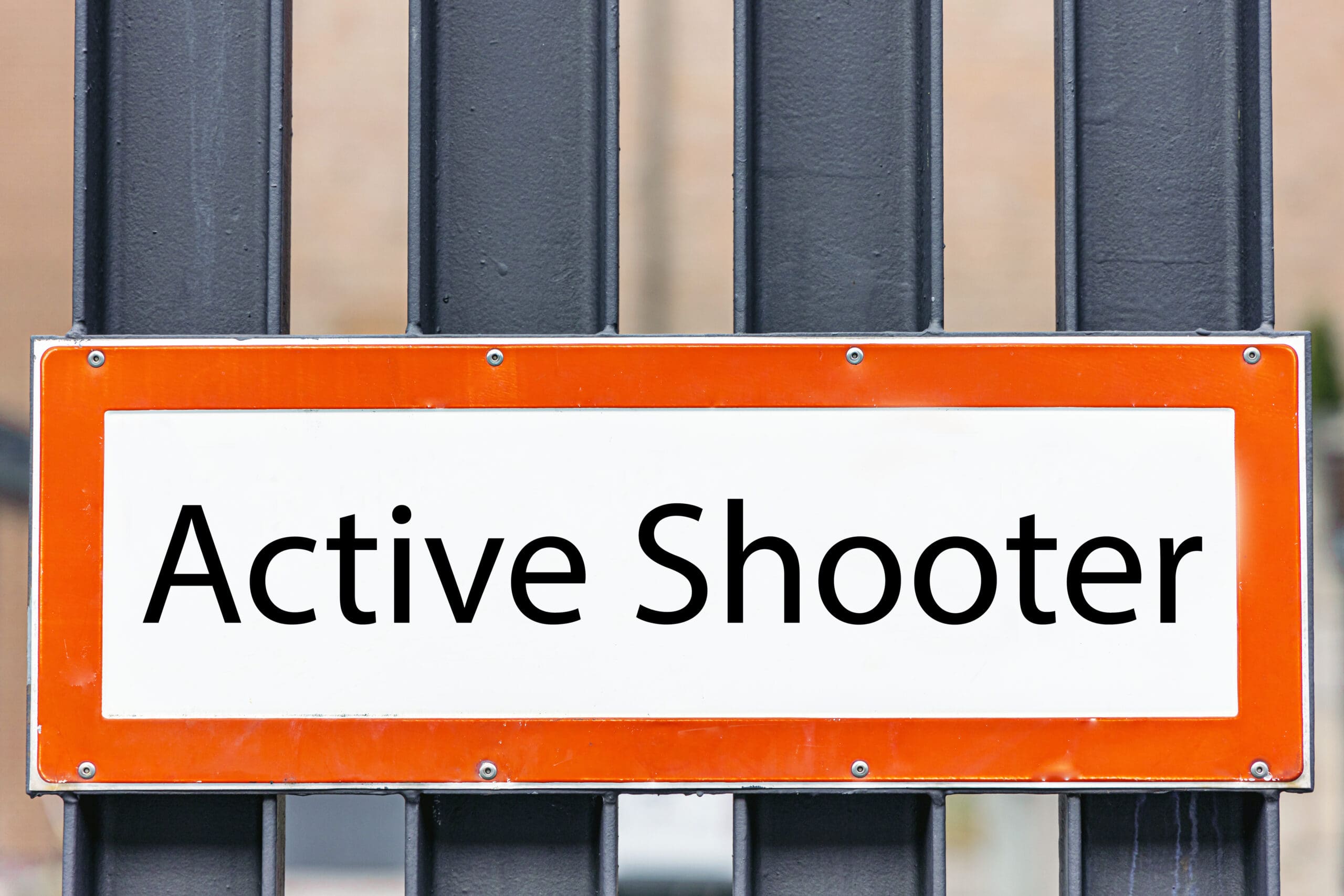There is intense debate among campus law enforcement and security professionals regarding the effectiveness of the many types of civilian responses to active shooters on campus. Run, Hide, Fight is the program that has received the most publicity, but other programs such as ALICE, Window of Life and many others have also been adopted.
The proponents of each method make compelling arguments. It should also be noted that all of the programs have similarities, so there is much agreement among the experts. For example, each approach places importance on the ability of students, staff, faculty, patients and visitors to evacuate. Some believe evacuation should be the first option for campuses, while others give it a lower priority, preferring to lockdown (which includes barricading doors, turning off the lights, closing the blinds and hiding) so a gunman can’t access or find his or her targets.
Many of the approaches advocate that faculty, students, staff and visitors fight back as a last resort. For obvious reasons, this option is the most controversial, particularly when applied in the K-12 setting.
Here, campus security and law enforcement professionals as well as consultants weigh in on which approach they believe works best.
Only Attack an Active Shooter as a Last Resort
The Fight aspect of Run, Hide, Fight and the Counter aspect of ALICE are getting the most attention. Unfortunately, according to Michael Dorn, executive director of Safe Havens International, some K-12 staff believe attacking a person brandishing a weapon is their first option. They believe this despite trainers specifically saying the Fight component should only be used as a last resort.
“We’ve noticed after Sandy Hook a distinct change,” he says. “Quite a few people are misapplying the information. We are seeing people when we put them in decision making situations — for example a student threatening to kill himself with a handgun. We have had three educators in the past few weeks say, ‘I would attack the gunman,’” rather than lockdown or evacuate the campus.
It should be noted that every single person interviewed by Campus Safety magazine for this article who believes in the Fight/Counter/Defend component agree that it should only be applied when all other options have been exhausted.
Teaching Kids to Fight Back Takes Too Long
Although there is agreement among Fight component supporters that it should only be applied as a last resort, there is significant disagreement within the campus safety community as to whether or not children in K-12 schools should be taught to attack an active shooter.
Brad Spicer, who is owner of SafePlans LLC, believes adults (faculty, staff and administrators), as well as college students should be trained in the Fight component, but K-12 students should not.
“The risk level isn’t enough for a K-12 school that they should devote the time it takes to train a student not how to fight back, but when to fight back,” he says. “That’s the thing that takes time to train: that critical decision making ability. We don’t want to see a student fight or resist when they should really be running or hiding. We take the time to train staff because they are adults and they have more life experience. They will understand when it should be applied.”
Lt. Joe Hendry of the Kent State Police Department, however, believes young children should be taught to attack.
“One of the recommendations with ALICE is that we train kids to do something, like we do for a fire,” he says. “With a fire, we teach them what to do if they are trapped in a building; if they are on fire; how to evacuate. We take those same concepts and use them for active shooters.”
Hendry notes that the swarm technique taught to adults should never be used with children.
“We teach them how to run, how to throw things and how to be loud,” Hendry adds. “Those are three things kids are good at anyway. Get the room to look like a Chuck E. Cheese. If you come into direct contact [with an active shooter], you want chaos. Most bad guys aren’t highly skilled, and that chaos works in our favor.”
He also advocates children use Stranger Danger (normally recommended as a response to an abduction attempt) when in direct contact with a gunman.
Attacking a Person With a Weapon Can Backfire
Spicer, however, believes the Stranger Danger approach won’t work because unlike active shooters who usually are suicidal, someone trying to abduct a child wants to survive.
Steve Satterly, who is the director of transportation and school safety for the Community School Corp. of southern Hancock County in New Palestine, Ind., also finds fault with the Stranger Danger approach, as well as teaching young children in the Fight component.
“I see the point where you don’t want to have them just passively sit there and die, but I’m not sure how effective they are going to be against someone who is attacking them,” he says. “Another thing I have to be concerned about as a director is liability. What kind of liability are we exposing ourselves to if we teach kids this and then they are killed?
“You are asking teachers who don’t have tactical training or experience, along with kids who have even less tactical training and experience to make that call,” Satterly adds. “There have been a number of teachers who have been killed trying to intervene. We’ve also had some success stories, but there is a much longer list of people who have tried and were killed.”
In some cases, attacking a person with a weapon can make a situation worse. Dorn and Satterly claim in a white paper they authored last year that students and staff throwing objects at a person with a weapon could easily trigger a shooting that would otherwise not take place.
“As a recent example, an incident occurred in Hastings, Minn., where a student brandished a loaded gun in class and the teacher was able to successfully talk the student into putting down the gun,” claim Dorn and Satterly. (To read more on the specific cases where fighting back has been successful and failed, visit www.campussafetymagazine.com/FightFlightOrLockdown).
What About Non-Active Shooter Incidents?
One of the greatest challenges with the Fight component to active shooters is knowing when to apply it. What if the situation isn’t an active shooter, but a violent attack on one person? Should a teacher or other administrator step in to stop the attack? According to Spicer, no.
“We recommend that everyone else run away from the area, or if you are in an area where you aren’t close to them, to hide and implement a lockdown,” he says.
Without adequate training, it is extremely difficult to quickly recognize what is happening during the first minute of a violent incident. All types — whether they involve an active shooter, a person with a gun or an edged weapon — usually are over in less than five minutes. Often teachers, hospital staff and other administrators don’t identify what they are dealing with until it’s too late.
“If you can recognize disturbing or concerning behavior early, you have more options,” Spicer advises. “If you are in a classroom and you identify a threat outside, that does allow the hide or lockdown to work. If no one recognizes the threat until they are in the hallway or room, your options are extremely limited.”
Teaching staff to identify the verbal and non-verbal indicators of violence (such as the use of profanity) can help them recognize a risk early. Threat assessment teams for K-12 and college campuses, as well as for hospital employee issues, can also help prevent violence.
That being said, sometimes there aren’t any warnings.
“I don’t think a lot of the incidents in hospitals have pre-incident indicators when someone is unhappy with their quality of care and they shoot a particular practitioner or when someone is estranged from their spouse,” says Universal Protection Service Director of Healthcare Services Rick Ward.
Assume the Worst, Hope for the Best
Most of the individuals interviewed for this article believe it is wise to assume the worst when a campus is dealing with an incident or suspicious activity. They can then scale back the response if appropriate.
“We don’t teach overreaction; we teach caution,” says Satterly. “It’s OK to call for a level of response that is not necessary and then back it down, as opposed to the other way.”
For example, if a school staff member sees a man sitting in a van outside of school, the campus can call for a preventive lockdown and contact police to check on the driver. If the man’s business is legitimate (e.g. He’s waiting to drop off music for his child who is in the choir), police can ask the man to check in with the front office. If the driver has ill intent, the staff member’s actions just might prevent the abduction of a child or some other crime.
To encourage this cautious and proactive approach, staff, faculty, medical personnel, visitors, patients, students and parents should not be punished for reporting suspicious activity. Additionally, because the first 30 seconds of an incident are most critical, campus line staff should not rely on top administrators for directions on how to respond.
“If you hear gunshots, don’t question it,” says Joe Bellino, who is Memorial Hermann Health Systems’ system executive for security and law enforcement. “It’s a gunshot, and move to the next level. Most people don’t know what gunshots sound like. If you see a person walking down the hallway (who isn’t a plain-clothes police officer wearing a badge), accept it. That’s a behavioral concern.”
Evacuation Removes the Target
A significant portion of campus officials embrace evacuation as the preferred response to an active shooter or other type of gunman or person brandishing any kind weapon for that matter.
“The thing we want to see the most from people is evacuation,” says Hendry. “That’s regardless of the facility or how tall the people are. Evacuation removes the targets, which lowers the body count. [Students, faculty and staff] are already trained in evacuation for fire. The training remains the same.”
Four years ago, Northern Virginia Community College (NOVA) experienced an active shooter incident, and NOVA Police Chief Daniel Dusseau believes many lives were saved as a result of students quickly evacuating.
“During our 2009 shooting, the student came in with a rifle, and the teacher told everyone in the room to get out,” he says. “When [the gunman] fired the round, there was no one in the room except the teacher.”
As a result of this incident and other developments, last year NOVA embraced Run, Hide, Fight.
“The gazelle doesn’t stay in place when chased by the lion,” Dusseau says. “If you can get out, get out, but we are much more detailed in the explanation.”
In the healthcare setting, some embrace the Run component as the first option despite the fact that it means some patients might be left behind.
“We can all understand why staff would feel torn,” says Ward. “But if you stay in a room with the patients, the potential for both of you to be killed is greater. If you get out and are able to call the authorities, the fact that you are a witness — was there only one shooter? Which direction was he travelling? What does he look like? — that is vital information that needs to be reported. You could potentially save many people, but that’s a personal decision for the caregiver.”
Lockdown May Be Best Option for Small Children
There are other hospital security professionals who believe staff shouldn’t leave their patients to flee the scene of an incident. Many K-12 campus protection professionals also are concerned about the ability of teachers and staff to effectively manage young children during a chaotic evacuation.
“The principle of en loco parentis ensures that we have a responsibility to others, and one of the assumptions of Run, Hide, Fight is that you are a free agent,” says Guy Bliesner, health and safety coordinator for the Bonneville Joint School District No. 92 in Idaho Falls, Idaho. “Lockdown still offers the best option in most cases. However, we allow flexibility in options for our teachers. We train with a move, secure, defend protocol. Move to a secure location (most often, but not always a classroom); secure the location (lockdown); prepare to defend if required. Students outside at the onset of a lockdown move to a predetermined location.”
Bellino also emphasizes flexibility with his hospital’s response to active shooters.
“You have a plan for where the incident is happening,” he says. “You have a plan for above and below and adjacent to [the incident]. Those plans can prevent loss of life if you know what you are doing and have the ability to lock doors and barricade. There are a lot of things you can do before running and escaping.”
In hospital settings and on campuses with small children where the occupants are totally dependent on staff, prevention strategies are extremely important. Those include locks, access control, threat assessments and more.
Are We Too Focused on Active Shooters?
All of this talk about campus community active shooter response may convey to some that this type of incident is extremely common. Not so, according to research by Dorn and Satterly. The odds that a child would die in school by homicide or suicide are no greater than one in one million.
So, are schools, universities and hospitals paying too much attention to active shooter incidents at the expense of other emergencies that are more likely to happen?
“Yeah, it’s understandable,” says Satterly. “The media really overplays it, and that’s what sells, but it doesn’t do a whole lot of good when you are looking at the realities of a situation and how to prepare for those realities.”
Satterly believes schools should approach the active shooter issue from an all-hazards perspective because it can be applied to active shooters and other disasters like tornadoes, earthquakes, Hazmat situations and more.
The active shooter response debate is also affecting campus design and construction. For example, at NOVA, some are debating the wisdom of putting in glass walls, which don’t allow people to hide behind them in the event a gunman comes on campus.
“Although that is true, there is still a greater likelihood that something will be stolen or a sexual assault will occur,” says Dusseau. “If the light of day is shining on that, it reduces its likelihood.”
Despite these challenges, many believe the focus on active shooters can have the positive effect of increasing overall awareness of campus security issues.
“Students are walking around all the time with their ear buds, and they are completely oblivious to their surroundings,” says Lt. John Weinstein, who is the commander of NOVA’s Safety District 3. “The shooter at our Woodbridge campus [in 2009] brought the rifle in a hockey bag. A student walking around campus with a hockey bag is a little out of the ordinary. We say you have to look at people critically, and if you do see something that is out of the ordinary, then you need to call the police.”
This article was originally published in 2014, but the issues that have been covered still apply today.













